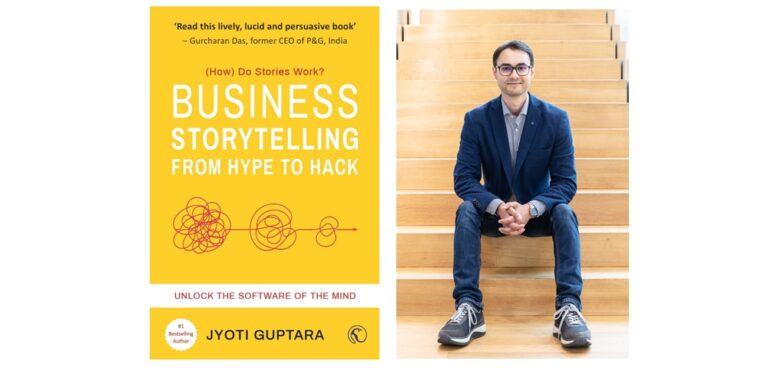By Jyoti Guptara, story strategist, speaker and bestselling author of Business Storytelling from Hype to Hack
In 2012, the IT industry was changing drastically from operation centric (‘helping run your business’) to business centric (‘creating your business value’). Fujitsu, the Japanese company, knew they had to articulate their envisioned future or risk being left behind. They assigned Yoshikuni Takashige for creating a vision document, but in 2013 the initial ‘Fujitsu Technology and Service Vision’ met with a cold response. Realizing the language was too technical for many business leaders, Takashige’s team replaced jargon with concrete images and, crucially, framed their vision with a narrative. Subsequent annual iterations of the strategy have enjoyed high engagement and support. The difference? Storytelling.
From storytelling strategies to strategy stories
Over the last decade, storytelling has become a buzzword in business, mainly in marketing or among leaders who want to improve their public speaking. But, given the power of narratives to provide a common understanding and vocabulary, adoption has been surprisingly slow when it comes to applying story techniques to overall business strategy.
Why? Is it because there is no need? The fact is that if you want to be shocked, ask co-workers what your organisation’s strategy is. You won’t have to reach the bottom of the hierarchy before getting evasive answers.
Even positive survey results can be misleading, as one CEO discovered when reviewing annual employee engagement. He had been delighted to see his colleagues apparently strategically aligned. But, while 97% of top leadership said that they understood the company’s strategy and aligned their work to it, when asked in more detail by researchers at MIT Sloan School of Management, a very different reality emerged. Only one-quarter of the managers surveyed could list even three of the company’s five strategic priorities.
And a third of the leaders charged with implementing the company’s strategy couldn’t list even one strategic priority.
Similar findings have been made across countries and industries. Strategy is notoriously hard to communicate. And even when there is awareness and alignment among the top leadership, that clarity hardly ever seems to reach the frontline.
That is disastrous, because it’s the frontline that produces the bottom line.
What’s the solution? “Repetition, repetition, repetition!” goes the traditional advice. Which is better than not repeating your strategy. But when the strategy doesn’t make sense to employees, are you not repeating, literally, nonsense?
By contrast, storytelling can help you communicate your strategy in a way that will be understood, embraced, and implemented. The great irony is that after putting huge effort and expense into developing company strategy, little thought is put into how best to communicate it. If you use the same thinking to communicate the strategy as you did to come up with it, you will fail – the rational process you need to produce strategy lacks the emotion and imagination you need to connect with people.
The four steps of strategy
Strategy development is not complete until you also have a strategy for communicating it, which requires the following stages:
1. Strategy development (research, debate, and decisions – the WHAT)
2. Strategy formulation (framing and wording the strategy – the WHY and HOW)
3. Strategy communication (the WHO, WHEN, WHERE)
4. Strategy implementation and monitoring
Too many companies go straight from step 1 to step 3 . . . and then wonder why step 4 doesn’t happen. If the strategy doesn’t connect with employees, it might as well not exist at all. Unless it ‘clicks’ and is both understandable and sensible it won’t ‘stick’ and be remembered and put into action.
Here is a simple and effective four-part framework for communicating a new strategy. Let’s keep them in mind as the Four Ps.
Part 1: Past – “In the past…” (how things were)
Part 2: Pivot – “Then something happened…” (the event(s) that caused the problem or opportunity, and how the present differs from the past)
Part 3: The Present Priority: “So now…” (the actions necessary to counter the problem or take advantage of the opportunity)
Part 4: Pitfalls and Potential – “In the future…” (the effects of the change – and what is at stake)
Not only is the 4P Framework useful for communicating a strategy “outwards” to colleagues and the market, the Framework is essential for efficiently producing that strategy in the first place. Do the leaders agree on the Four Ps? If not, how do we get agreement?
The Framework gives the big picture. But after creating the big picture, zoom in and paint the details of that picture, or it will remain foggy. Do both and buy-in will skyrocket. Model behaviour with stories and behaviour will change.
While the best business strategy stories take hard and systematic work to identify, clarify and articulate, storytelling is often neglected because stories are simple. But that is precisely why they work. The deceptively simple framework of a story lets us combine all sorts of things that often don’t go together in business – information and imagination, fact and feeling, causality and a greater cause.
When you communicate, do you want to address the narrow part of people that responds to slogans and statistics? It can work. But you’ll get what you invested in – only a narrow slice of your people. If, by contrast, you engage the whole person – head and heart – you will get so much more. And it will show.
Purpose leads to passion. Passion unlocks potential. Performance soars.
Now a celebrated story strategist, speaker & bestselling author of Business Storytelling from Hype to Hack, Jyoti Guptara helps purpose-driven companies scale their influence with strategic narratives and narrative strategies with key focus on leadership storytelling, creating organizational story banks, and virtual reality storytelling. He helps organisations and business leaders use storytelling for more success with less stress.

